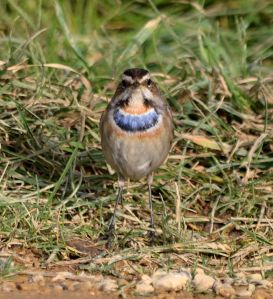The rather exceptional discovery last Friday of what has become a showy wintering Bluethroat in the Lincolnshire fens was a suitable draw for two reasons. I have encountered the species briefly twice before at Larnaca Salt Lake, Cyprus (Nov 2011) and after much searching Tavira Marsh, Portugal (Jan 2014), but had yet to observe an adult male. So the opportunity to add a first winter male to my British bird list just 110 miles from home was not one to stand up.
The nearest wintering Bluethroat to Great Britain are normally in the south of France and the Iberian peninsula, and are of the southern white spotted sub-species. There is currently some discussion amongst birders online about the origins of today’s bird, that could be of the Scandinavian red-spotted sub-species or other forms occurring further east in Russia. But such taxonomic concerns were of less interest to me than getting what is a regular though declining passage scarcity onto my British list
I headed north in reflective mood after events in the previous two days. At my charity shop on Monday there had been a murder in the street outside. But more particularly, after deciding to go for this bird yesterday I learned of the death of a good (non-birding) friend after a brief hospitalisation with cancer. I felt no inclination for the usual accompaniment as I travelled what has become a familiar route via Northampton and Peterborough. Instead I pondered the transience of all the many phases of our lives and what the remainder of my own might hold.
I arrived at Lincs’ Wildlife Trust’s Willow Tree Fen reserve near Spalding at 12:30pm after taking the best part of 30 minutes to remember where it was. I had been here once before in August 2015 (see here) to see a beautiful Red-footed Falcon, probably my British bird of that year which subsequently was also murdered. There seemed to be a general movement of birders off the reserve, but I was directed to a group along the main track where the Bluethroat was said to be popping in and out of reeds to one side. Many close-up pictures taken at this spot, reflecting various degrees of expensive technology, had appeared on RBA and Bird Guides over the preceding days.
Upon my arrival a minibus carrying school children passed slowly in the opposite direction. Considerate yes but not especially helpful, and a dog was also present. None of the birders waiting here seemed to have seen the Bluethroat yet. Having made a late departure after working an evening shift I now feared the worst. But after just a 20-minute wait, and once the dog had gone, a murmur of: “There it is,” issued from my left. The bird had emerged from the reeds right in front of me. This (below) is what I call a result.
The above images were all captured with my entry level Nikon SLR and 300mm telephoto lens. I would like to dedicate them to the memory of Jeremy Hill, who was a very fine man and will be sadly missed by all who knew him. My thoughts throughout this twitch were with his widow Penny, one of my longest standing friends and their sons Sam (17) and Tim (15).
The Bluethroat spent several minutes moving about and feeding in the grass beside the track, where food must have been put down for it by photographers and/or other people with cameras. Mealworms were mentioned by some birders around me. As in the Algarve three years ago I was struck by the larger size of this Robin-like passerine, and also by the way he constantly flicked his cocked tail. From time to time he just seemed to stand and look back at the line of observers who were all so fascinated by him (pictured below).

Who might this be?
Finally and rather coquettishly he flipped back into the reeds from whence he had come, and immediately I thought of my stomach. After a sandwich break back at the car I decided not to linger further and so headed home. Standing in line watching a bird at such close range always seems a little contrived to me, especially if it has been baited with food. But I am unlikely to get better views of a rather under-represented species in my past records that is now well and truly ticked for blighty (no 335). I believe this is only the second British wintering Bluethroat this century.
Winter is almost over now, and I have negotiated the dark season without a break abroad. That has been a difficult, at times brutal ride, as needs must but also an experience that instils some sense of achievement. Hitting the road to “see a bird” always helps: that is why I do it.





